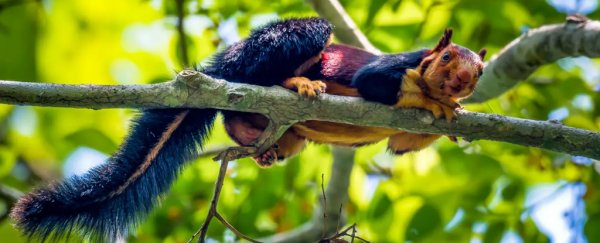Sure, you might think your average acorn-chomping grey squirrel is sort of cute. But seriously, it's never going to be giant rainbow squirrel from India level of cute.
It's not just our opinion either. When amateur photographer Kaushik Vijayan posted some pics of Malabar giant squirrels (Ratufa indica) on Instagram, they quickly wowed the internet.
Vijayan took these snaps while in India's Pathanamthitta District on the south-western tip of the sub-continent. Once he'd uploaded them to his Instagram account, the pictures quickly went viral.
Incredible #pictures of giant multi-coloured squirrels set #social media alight!#Photographer Kaushik Vijayan snapped the animals in their native habit. The Malabar Giant #squirrel - double the size of their grey relatives - live deep in the #forests of #India. pic.twitter.com/BLFRZf6VHy
— SWNS.com (@SWNS) April 2, 2019
"I felt so amazed by how drop-dead gorgeous it looked," Vijayan told CBS News.
"It was indeed a jaw-dropping sight to behold."
No arguments there. Just look at this floofy face!
The technicolour bundles of pure adorb aren't in any way new to zoologists or locals. In fact, they've probably been on the menu for millennia.
Still, to most of us the metre-long (about three-foot) rodents look like they've popped right out of a Pokémon cartoon, what with their panda-like ears, round faces, and alluring purple, indigo, and orange bands of fur.
In nature, not all of them appear as striking as this specimen in the vibrant photos - hues of beige, tan, rust, and brown are the most common. But why does India get giant squirrels of joy, while the rest of the world gets monotones of grey, red, and black?
Colourations of this nature are most likely a way to confuse predators in the contrasting shades of the canopy. It's also possible they could attract a mate's attention.
Lucky for us, the Malabar giant squirrel is now fairly common in the forests of the Indian peninsula after being listed as vulnerable some twenty years ago. Hopefully, they'll stay that way for generations to come.
You'd need to look up though – they're often hugging trees high up off the ground to hide from predators. When the squirrels do hit the road, they prefer leaping up to six metres (20 feet) between trees instead of touching the forest floor.
Or, you can just wait for Vijayan to go back to southern India and take some more snaps.


